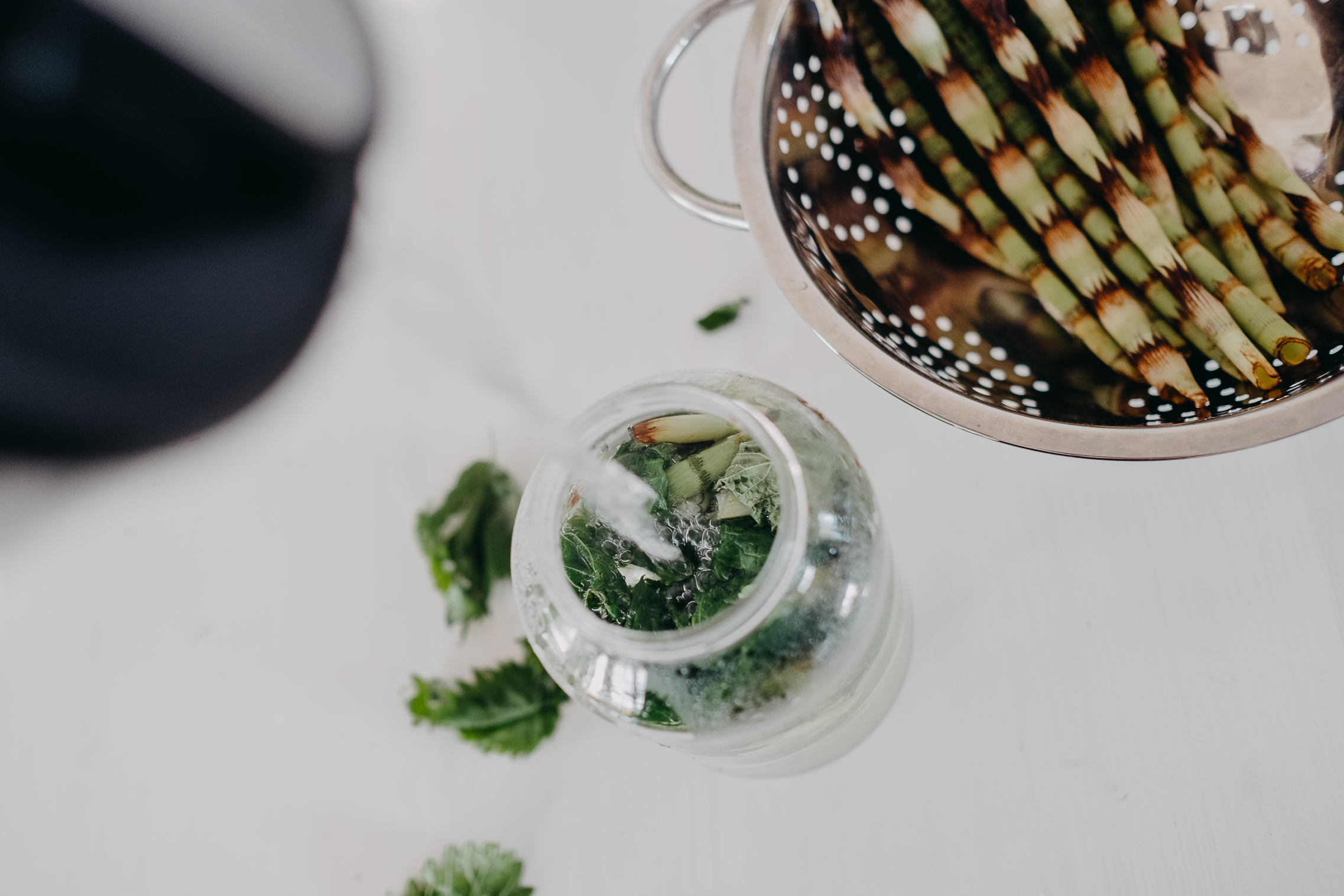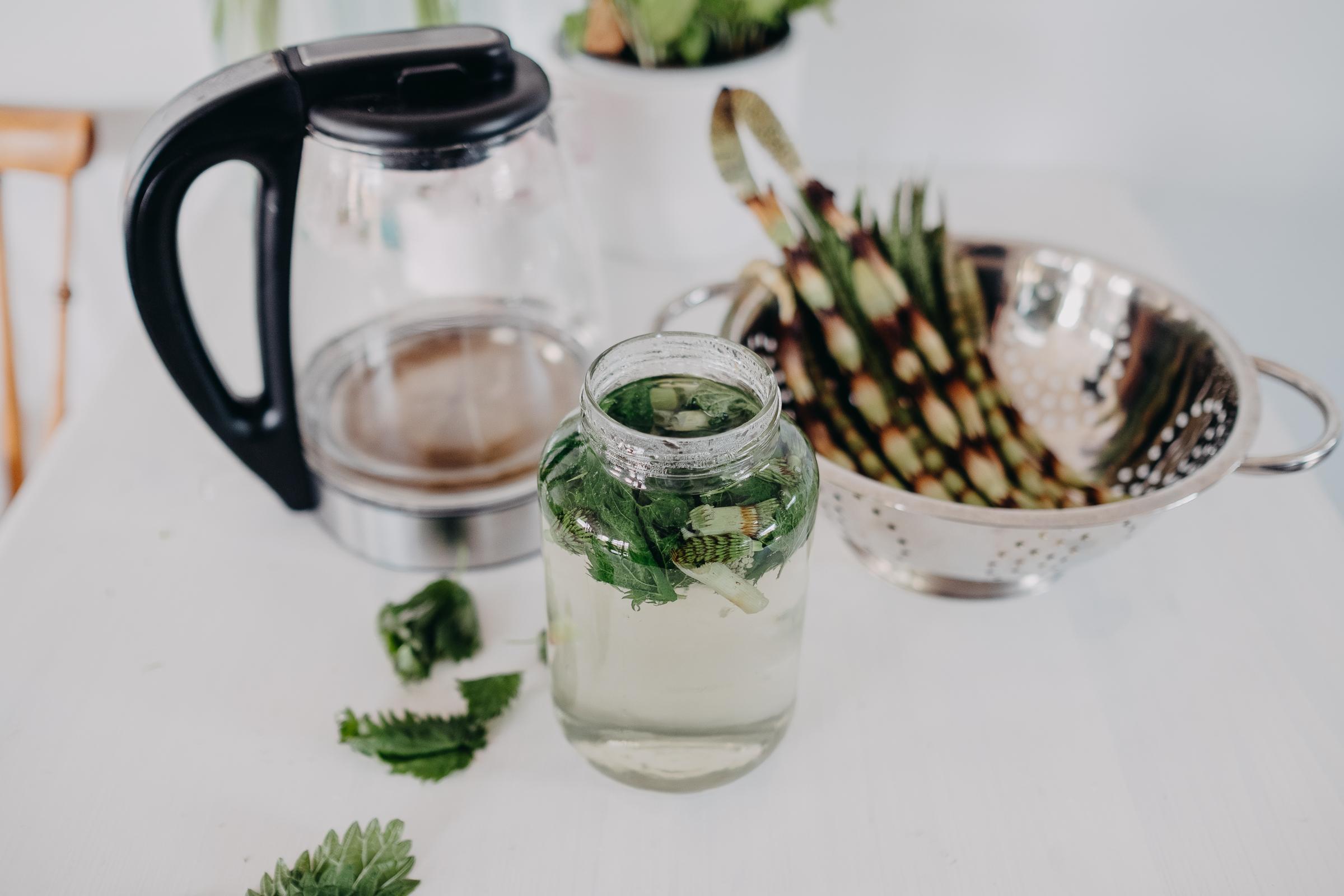Stinging nettles for allergies, hair & skin
From left: stinging nettle, horsetail, maple blossom
Is spring time your least favourite season? Do your eyes and nose get runny? Do you start sneezing like it’s going out of fashion the second you step your foot outside the door? Are you the first to know when flowers and trees start sprouting due to seasonal allergies? Are strong antihistamines the only way for you to survive this painful season? All my life i have never ever felt a single symptom of seasonal allergies, until now. This year, for the first time ever, i can say that i understand the struggle. A couple weeks ago when all the pollen started moving around in the air and trees started blossoming, i felt like my head was going to explode from all the snot and glossy, watery eyes. Gross, i know! And then i came across this article about stinging nettles, which btw are in season right now, and how they are very high in natural antihistamines. YES, you read that right, a natural source of antihistamines for seasonal allergies! After only a few days of drinking 2-3 cups of nettle tea all my spring allergy symptoms vanished completely. Once again, turning to nature for help did not disappoint.
Histamine is a substance your body produces when an allergen, like dust or pollen, comes in contact with your mucous membranes (nose, mouth, throat, lungs, stomach, intestines). This is called an allergic reaction, which is basically your immune system responding to an otherwise harmless substance. An antihistamine is a substance that blocks this immune response to some extent, reducing the typical allergy symptoms (sneezing, itchy eyes, sinus congestion, hay fever etc).
You can get many different over the counter medications for allergies, which contain antihistamines, but the list of side effects from these medicines are quite long and quite scary. Some very common symptoms include dry mouth, dizziness, nausea, vomiting, restlessness, mood swings, trouble urinating, blurred vision, confusion, and in rarer cases hallucinations and seizures.
STINGING NETTLE
Has astringent properties which help reduce oily skin, and can therefore be very helpful in treating acne and blemishes.
A source of all 9 essential amino acids (proteins the body can’t produce but need from food sources).
Has anti-inflammatory properties which can help reduce symptoms of rheumatoid arthritis, gout, bursitis, and tendonitis.
Rich in calcium and iron which has a stabilizing effect on hormone production, helping to ease the effects of fluctuating hormones before and after menstruation or pregnancy. Nettle tea contains potassium and can help relieve muscle cramps or discomfort during menstruation.
Nettles have very high concentrations of vitamin C and iron, which stimulates red blood cell production, and can help treat anemia. Nettles also increase the production of nitric oxide, which relaxes blood vessels and therefore lowers blood pressure.
Improves insulin production, helping the body to keep its blood sugar levels in balance.
Alongside antihistamines, nettles also contain the neurotransmitters serotonin and acetylcholine. These 3 together produce powerful allergy relief without the drowsiness and other nasty symptoms of allergy medication.
Contains impressive amounts of antioxidant, flavonoids, carotenoids, and vitamins which help strengthen the immune system by stimulating T-cell activity.
This crazy plant packs quite the power punch. I have been picking my own stinging nettles since i was a little child, adding them to stirfrys and soups, but also drying them slightly and making tea out of them. Almost all health food stores carry some sort of nettle tea, but if you do decide to go out and harvest some yourself, be sure to bring a pair of garden gloves! Fresh stinging nettles are covered with tiny, fine hairs called trichomes that produce a painful stinging sensation upon contact (hence the name)! Once they have been soaked in hot water for 10 minutes or dried, the trichomes are no longer active and won’t sting you. Don’t be intimidated though, nettles are super delicious, both as a food and for your skin and hair!
NETTLE & HORSETAIL HAIR RINSE
If hair rinses aren’t part of your weekly hair care routine, you are missing out big time! A herbal hair rinse helps balance the pH after washing your hair, reducing breakage and damage, and adding shine and strength to your hair. Stinging nettles and horsetail have a very long history of being used specifically for hair care, as they are rich in minerals and trace elements that strengthen the collagen in hair, nails, skin, and all other connective tissues. Right now you can find these wonder plants almost everywhere.
To make the rinse place a handful of nettle leaves and chopped up horsetail in a large mason jar and pour hot water over them. You can let them steep over night or 30 minutes before taking a shower. Strain out the plant parts right before use. Wash you hair like you normally would (did you know that my Kesä soap bar contains local, wild harvested nettles, and is a great shampoo bar?), and right at the end slowly pour your hair rinse all over your hair as a finishing rinse. If you have long hair like me, dip your hair ends into the mason jar for a minute or so before pouring the rest over your scalp and hair. Don’t rinse your hair with water after this anymore, leave the hair rinse in, and genlty dry your hair with a towel.
Nettles have astringent properties, making it a powerful remedy for oily and acne prone skin types. This same hair rinse can be made into a facial toner. Let the nettles steep over night, strain the plant parts out, and put into a clean glass spray bottle. Every morning and night, spray some of this toner all over your skin before applying your moisturizer, and you can kiss your breakouts goodbye!






